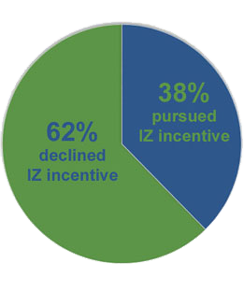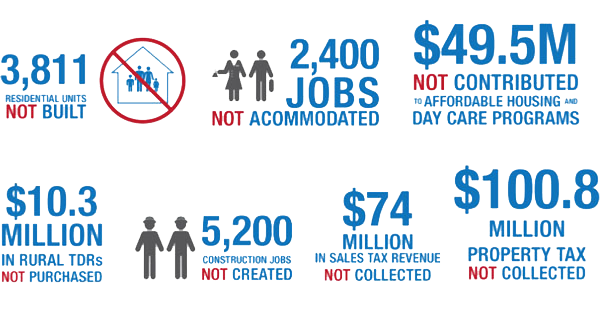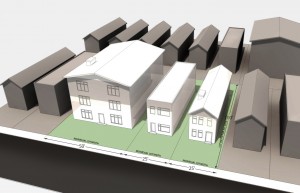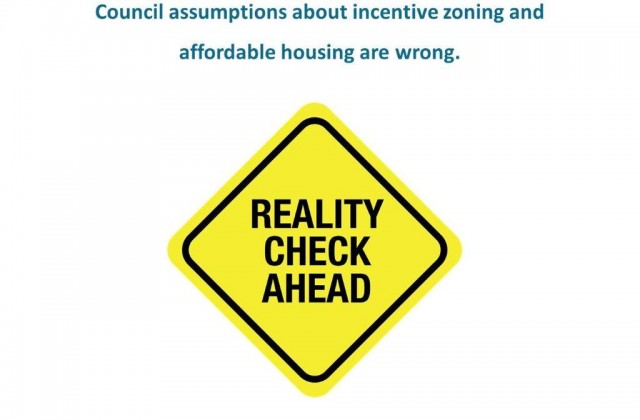Study: Density Increases Value of Existing Homes
Publicola picked up on an important point yesterday when they called out State Representative Gerry Pollet’s assertion about the impact of small-lot development. Here’s part of the Publicola post:
But more important, Rep. Gerry Pollet, who’s been holding town halls of his own all session, definitely needs to explain his recent comments to KIRO TV, which Erica flagged in yesterday’s OOBT. Rep. Pollet, who ran a bill to require notice when developers build small-lot houses, described the housing as “monstrosities, they ruin neighborhoods, they literally destroy the value of the houses next door.”
Question for Pollet: Does he have any proof that property values have declined as a result of small lot development?
It’s a good question and hopefully Representative Pollet will call Anne Vernez Moudon a professor at the University of Washington which happens to be right next door to the Laurelhurst neighborhood where so much fuss is being made about some new homes. Before he does his next town hall he might ask her the question. Here’s what she said about a study she worked on asking the very same question about density and property values:
The results should not come as a complete surprise,” Moudon said, “as it is well known that property values in neighborhoods like Queen Anne, packed with dense, single-family development and intermittent low-rise apartment buildings and condos near retail, are substantially higher than in some of the county’s sprawling subdivisions.
I’ve heard Moudon speak before and she’s pretty sharp. I trust what she says. Maybe she can persuade Representative Pollet that small-lot development is better for home values than “sprawling subdivisions.”
What the data show is that value of homes tracks with many factors including overall neighborhood quality, schools, walkability, and access to retail nearby. People want to live in vibrant neighborhoods that are close to things they need and want. New single-family homes, like those that would be built with the 80 Percent Rule, add to the overall quality of life and provide a housing opportunity for families that might end up moving somewhere else.
Here’s more information on Representative Pollet’s upcoming town hall.
Who: State Rep. Gerry Pollet, state Rep. Jessyn Farrell, and state Sen. David Frockt — 46th Legislative District Democratic lawmakers.
What: Tele-Town Hall for citizens who live in the 46th Legislative District, which includes neighborhoods of North Seattle and Northeast Seattle, as well as Kenmore and Lake Forest Park.
When: 6 p.m. to 7 p.m., Tuesday night, Feb. 25, 2014.
Where: Seattle and Olympia.
Shortly before 6 o’clock that evening, thousands of 46th Legislative District citizens will receive phone calls inviting them to stay on the line and participate in the Telephone Town Hall. Folks who want to ask a question in this phone program will need simply to press “*3” (i.e., press the “star” button and then press the “3” button). If for some reason a citizen doesn’t get the call, he or she is encouraged to call the toll-free telephone number directly, 1-877-229-8493, and then enter PIN code No. 18646 when prompted to join the discussion.
Pollet to O’Brien: Stop Single-Family Home Building
 State Representative Gerry Pollet, a Democrat from Seattle’s north end, introduced legislation to mandate notification of neighbors when a new home is being built in a single-family zone. Fortunately, Representative Pollet’s bill, which only had one other sponsor also a north end legislator, died in the State Legislature. Pollet’s efforts aren’t really about notice, but trying to please his well heeled north end constituents, with lots of money to hire lawyers, who don’t want anyone else moving into their neighborhoods.
State Representative Gerry Pollet, a Democrat from Seattle’s north end, introduced legislation to mandate notification of neighbors when a new home is being built in a single-family zone. Fortunately, Representative Pollet’s bill, which only had one other sponsor also a north end legislator, died in the State Legislature. Pollet’s efforts aren’t really about notice, but trying to please his well heeled north end constituents, with lots of money to hire lawyers, who don’t want anyone else moving into their neighborhoods.
Here’s what the opponents of single-family housing say about notice:
Worst of all, because no notice is given to neighbors, many miss out on their only opportunity to protest or stop the construction of a backyard / side yard house: a LUPA lawsuit. (Under state law, LUPA lawsuits must be filed within 21 days of a backyard / side yard house project being approved. But, how can citizens be expected to file a LUPA suit within that timeline when they’re never notified?)
Representative Pollet knows this isn’t about participation or democracy but about the appeal. If noticing these neighbors meant they came over and brought fresh baked cookies that would be one thing, but the notice is intended to provoke a lawsuit against, ironically, the City of Seattle which would likely be unsuccessful anyway. The intention is to stop new housing, pure and simple.
If some neighbors want to know what can be built in their neighborhoods the best thing the City Council can do is pass the 80 Percent Rule, a proposal we’ve been advocating for over a year. The 80 Percent Rule would:
- Allow the development of lots that are 80 percent of the average block face facing a street;
- Limit the height of proposed new homes to 22 feet;
- Include set backs for front, side, and back yards; and
- Have a lot limit of 2000 to 2500 square feet.
This proposal would allow everyone to know exactly what can be built and what can’t long before anyone even seeks a permit. The 80 Percent Rule is a pragmatic and sensible response to a complicated code that confuses builders and neighbors. Making it easier to understand helps everyone — unless all you want to do is stop new homes from being built.
And what about Representative Pollet’s quote in the KIRO Story that ran last night?
“These are monstrosities, they ruin neighborhoods, they literally destroy the value of the houses next door,” said Pollet.
Representative Pollet is wrong on three counts. First of all, if the 80 Percent Rule passed, houses would be much smaller than the allowable 37 feet tall than is currently allowed in single-family zones. The idea that new infill developments are monster houses is absurd, especially when you ask, “Compared to what?” Usually infill homes are smaller or the same size as surrounding homes. We did a study of what our homes would like under the 80 Percent rule compared to what is already doable under existing code in single-family neighborhoods. Our houses are smaller and perfectly in scale.
Second, where is the example Representative Pollet can point to of adjacent houses actually losing appraised or market value from new construction – any new construction? We’d love to see those examples. He might have to wait until the interim because it’s going to take a long time to find any post real estate bubble drops.
Third, some neighbors want to exhaust the hard working builders trying to increase housing choices and options for people who want to live in their neighborhoods, bogging down new homes with process and appeals. Some neighbors want to protect their real estate investment by keeping new people out, a strategy that, in the end, will only hurt their investment.
And lastly, I’d love to see Representative Pollet call an actual person’s house a monstrosity to their face. It’s easy to call people’s homes (homes they’ve worked and saved to build) names when you’re way down in Olympia.
The City Council should protect the rights of people who want to build new homes and access to housing choices for people who want to live in our city, whether it is in small-lot housing in Green Lake, microhousing in Ballard, or an accessory dwelling unit in the Rainer Valley .
If they want transparency, upset neighbors should support the 80 Percent Rule which would make the land use code in Seattle easier to understand and more predictable for them and builders creating places for people to live. Using the legal process to bog down builders will costs jobs, increase housing prices, and create a poisonous atmosphere for new people moving to our city.
Let Councilmember O’Brien know what you think about this issue and e-mail him at mike.obrien@seattle.gov.
Council Study Reveals The Inherent Futility Of Incentive Zoning
Seattle City Council asked for a reality check on Incentive Zoning (IZ) and now they have their smoking gun: Since the Program’s inception in 2001, 62% of eligible development projects declined to participate. That outcome demonstrates that the IZ Program is not only fundamentally broken, but also has resulted in the loss of significant public benefits, and hindered progress towards the City’s own sustainable development goals.
 It’s pretty simple: Most developers said “no thanks” to IZ because the incentive offered by additional development capacity was not sufficient to offset the additional risk and cost. And one component of that additional cost is the requirement to include subsidized affordable housing in the project, or to pay for its construction elsewhere, a.k.a. an in-lieu fee.
It’s pretty simple: Most developers said “no thanks” to IZ because the incentive offered by additional development capacity was not sufficient to offset the additional risk and cost. And one component of that additional cost is the requirement to include subsidized affordable housing in the project, or to pay for its construction elsewhere, a.k.a. an in-lieu fee.
Given the historic low participation rate in IZ under its existing encumbrances, it would seem obvious that increasing the requirements for affordable housing will only tip the scales further toward non-participation, in which case zero affordable housing is produced. When the toll is raised, the gains made from the projects that still opt in to the Program will be offset by the increasing portion of projects that decline. And this inherent “diminishing returns” aspect of IZ is why it should never be expected to have a consequential impact on Seattle’s affordable housing needs.
I wrote “would seem obvious” above because apparently it is not obvious to Seattle City Council, and all indications are that some Councilmembers will be seriously considering either raising the IZ in-lieu fees (again), or more likely eliminating the in-lieu fee option altogether and thereby requiring developers to subsidize the full cost of including affordable units in their projects.
In the South Lake Union neighborhood, Council recently imposed in-lieu fees that are up to 43% higher than the historic fees in downtown, and what is the result so far? Of 20 eligible development projects in the pipeline, 14 are not participating—a no thanks rate of 70%. South Lake Union could be considered a best case scenario for IZ, since it is one of the hottest real estate markets in the country. But even under ideal market conditions, for most projects the incentive was insufficient to overcome the encumbrance.
Based on the estimates of Council’s affordable housing consultant, mandating inclusion of affordable units in projects would be equivalent to jacking the in-lieu fees by a factor between about two and four.* It’s hard to conceive how this would not lead to a precipitous drop in IZ program participation. And again, that would result in even less affordable housing produced, along with underdevelopment in urban centers that runs counter both to Seattle’s Comprehensive Plan, and to the greater region’s goals for sustainable growth. Same goes for tweaking IZ to require affordability levels deeper than 80%AMI (i.e. where the real need lies)—the opportunity cost to developers will rise significantly due to the greater requisite subsidy, and the IZ participation rate will drop.
Since 2001, IZ in Seattle has generated about $27 million from in-lieu fees, which resulted in the production of about 600 affordable rental units, if the effect of leveraging funds from other sources is included. Council’s consultant predicts that because funding sources that have been leveraged in the past are drying up, from here on out the City should anticipate about a doubling of their expenses to produce affordable housing*—in other words only about 300 units could be produced from that $27 million. For reference, $27 million would cover the turn-key production costs of only about 110 typical multifamily units. To put those numbers in perspective, during that same time period, some 46,000 multifamily units were built in Seattle.
Some would argue that even though IZ produces a miniscule amount of affordable housing relative to the need, it’s still better than nothing. But this argument becomes indefensible when you consider the negative impacts of the underdevelopment that IZ can cause. The Downtown Seattle Association has published estimates of a wide range of public benefits that were forgone based on 25 projects in downtown and South Lake Union that opted to not participate in the IZ program, illustrated below:

City Council must be held accountable for putting this magnitude of public benefit at risk through the imposition of IZ. Granted, the added encumbrance of providing affordable housing is only one of many reasons developers might opt to forgo the maximum development capacity allowed through IZ. But those other factors will always be part of the development equation. And in any case, piling on affordable housing is guaranteed to tip the scale in the wrong direction, especially if the requirements are made more onerous, which is the direction the political winds are blowing.
The potential sacrifice of 3,811 new housing units is the most glaring illustration of how IZ is an intellectually bankrupt policy. The biggest driver of Seattle’s current housing affordability crunch is demand outstripping supply. When thousands of new housing units go unbuilt, that means thousands more households competing for existing housing, and at the end of the day, it will be the poorest households that get priced out. And it also means thousands more housing units likely to end up built in sprawling outlying areas.
To sum it up with bad cliches, Incentive Zoning is like trying to squeeze blood from a stone, and robbing Peter to pay Paul, and shooting yourself in the foot, all rolled into one. Given that in this case the stone is such a politically expedient scapegoat, there is no question that City Council’s life would be easier if the above cliches weren’t so apt. But the sooner Council accepts the inherent futility of IZ, the sooner they can get on with the hard work of developing better housing affordability strategies—that is, strategies that—unlike IZ—encourage market production of housing supply to help ease prices, have the potential to generate funds for subsidy commensurate with the need and cost, and place the tax burden on all property, not just new development.
>>>
*The Cornerstone Partnerhip’s estimates provided to City Council: Opportunity cost to developer of affordable units built in project = $100k – $200k/unit; In-lieu fee = $56k/unit; Historic cost to City = $44k/unit; Future cost to City = $95k/unit
>>>
Dan Bertolet is an urban planner at VIA Architecture and blogs at Citytank.
NAIOP Joins Smart Growth Seattle
The Washington Chapter of NAIOP has joined Smart Growth Seattle as a sponsor. NAIOP is the commercial real estate association for developers, owners and investors in the industrial, office and related commercial real estate industries.
NAIOP has become a Smart Growth Seattle sponsor because the organization’s work is consistent with NAIOP’s land use agenda in Seattle.
“Affordability in Seattle is a complex topic and we want to encourage a dialogue that focuses on holistic solutions and flexible policy, not just additional fees that could end up limiting supply,” said Don Marcy, Chair of NAIOP’s Government Affairs Committee.
NAIOP has joined with Smart Growth Seattle to support policy that allows the market to advance creative solutions to meeting housing needs, such as microhousing.
“We should discourage policy that overregulates this important tool for meeting housing demand,” said A-P Hurd, President of NAIOP’s Washington Chapter and Vice President of Development at Touchstone, also a Smart Growth Seattle sponsor.
NAIOP also opposes changes to the LR3 Zones in Seattle, since these zones are uniquely able to sustainably welcome more people with a diverse range of multifamily housing products.
“For the past 5 years, we have been involved with the Quality Growth Alliance (QGA) and are acutely aware of the need for Seattle to accommodate growth and meet our GMA targets” added Hurd, “The current mix of building types allowed under LR3 zoning is an important part of meeting those goals.”
NAIOP’s over 700 members represent most of the region’s leading firms in commercial and mixed-use real estate development.
The chapter’s presence is well known in political circles, and its members have successfully impacted proposed legislation that affects the real estate industry. Sponsorship of Smart Growth Seattle is part of NAIOP’s goal of also positively impacting housing policy in Seattle.
NAIOP’s Washington State chapter is also known for its philanthropy, with hundreds of its members volunteering each year on projects ranging from stream recovery to social service center renovations.
Incentive Zoning:Wrong Problem, Wrong Solution
There is abundant quantitative evidence that puts to rest the idea that there is a lack of “workforce” housing. The market is producing many new units of housing priced at 30 percent of he monthly income of people who earn 60 to 80 percent of Area Median Income (AMI).
The City Council may have already made up it’s mind about incentive zoning, but hopefully they heard the expert panel at last week’s housing forum affirm what we’ve already been saying: create a housing policy that allows for a lot more housing for people at all levels of income. The biggest housing supply problem is housing priced for people with lower incomes, less than 60 percent of AMI.
What is just as important is the critical point made at the forum that the tool the City is using and wants to keep using to address housing prices won’t help housing supply or price; incentive zoning makes the problems of supply and price worse by adding costs and risk to housing that’s already meeting workforce housing demand.
The slide show from the Downtown Seattle Association below lays out the case clearly. It is important to note that developers are walking away from the “incentive” because it really isn’t an incentive; of the projects citywide eligible for the program 62 percent didn’t participate. If there was financial benefit to paying for additional wouldn’t developers take advantage of that benefit? But there isn’t a benefit for most projects, that means less housing got built.
The slide show makes the case against incentive zoning with publicly available data from local governments, information available to the Council and their staff.
The City needs a comprehensive approach to housing that boosts supply, allows for sustainable growth in our city, and addresses the needs of people who struggle with poverty.
However, imposing fees on new growth and price controls on new housing will limit supply, drive up costs, and, in the end, pit renter against renter for scarce housing, a bidding war poor people lose every time.





